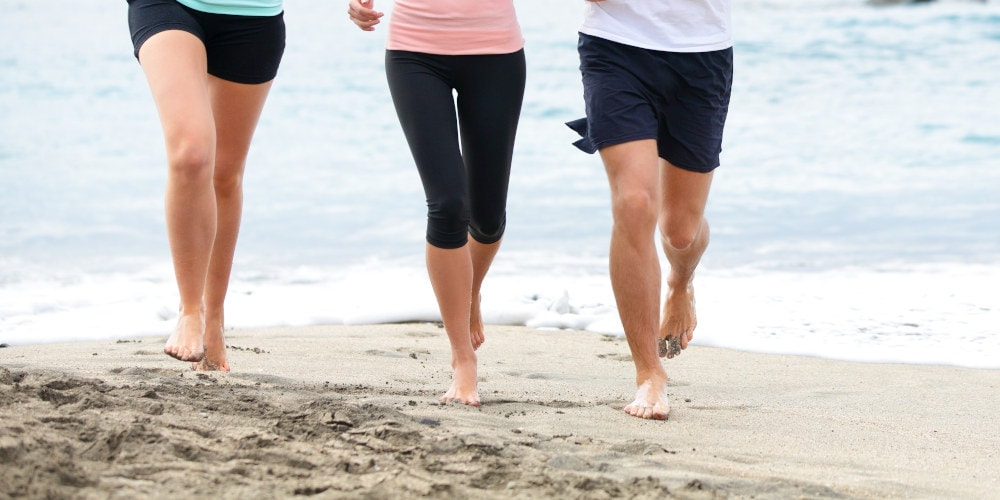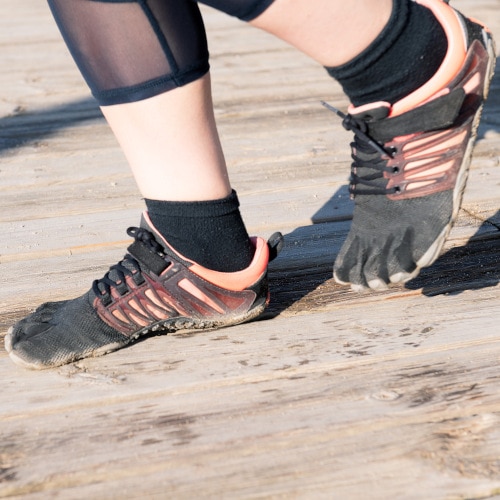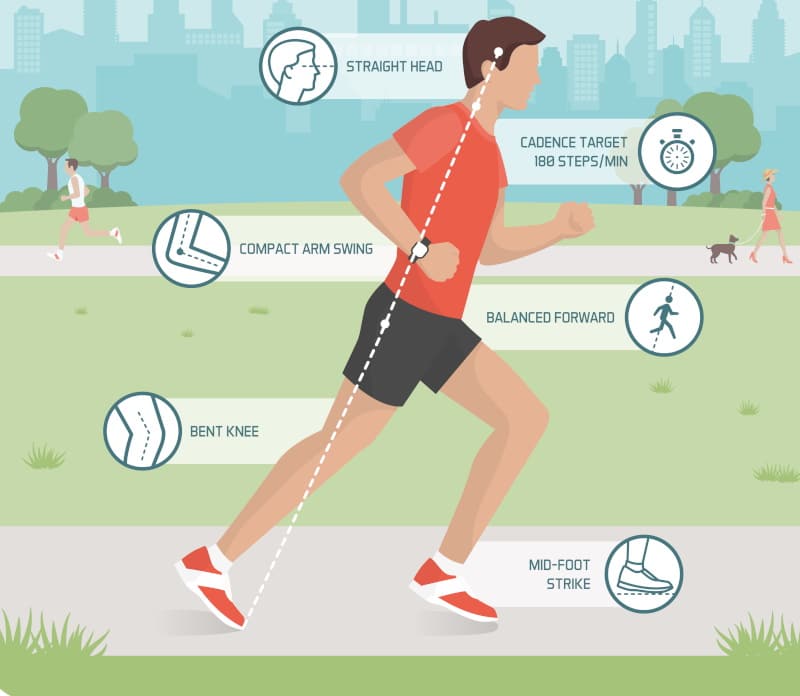What is barefoot running?
Firstly, barefoot running is a misnomer. It doesn’t necessarily involve running with nothing on your feet. Huh? Barefoot running describes a style of running – a more natural style where runners wear a lighter foot covering rather than a regular running shoe. It’s also known as minimalist or natural running.
There is a different foot strike pattern depending on whether you wear shoes while running or run barefoot. Barefoot running involves the foot striking the ground forefoot first, rather than heel-first. With a barefoot stride, the forefoot lands right under the body’s center of mass, rather than out in front. This results in a shorter stride and faster cadence (number of strides per minute). Cadence is a measure of athletic performance and increasing cadence can be beneficial.
Since all of life can be explained via the science of physics, barefoot running is no different. Barefoot running helps propel the runner forward because the angle of impact allows for vertical forces to be converted into rotational forces. The forefoot strike helps conserve forward momentum, this reduces the harmful breaking forces often seen in heel strikers. This is a more natural way of running that may be gentler for the body.

Born to Run and the start of the barefoot running trend
Christopher McDougall was a long-distance runner who, like most American runners, repeatedly sustained injuries. He began researching the reclusive Tarahumara Native Mexican Tribe – a tribe that ran barefoot. McDougall marveled at the tribe’s ability to run ultra-distances (100+ miles) at incredible speeds without getting the routine injuries many runners suffered.
When it came out in 2009, Born to Run, a book based on his research, was widely praised. The book received attention for his description of how he overcame injuries by modeling his running after the Tarahumara runners. He asserted that modern, cushioned running shoes are the major cause of running injury. Comparatively, Tarahumara runners (who wore thin sandals) had a low incidence of injury.

What are Zero-Drop running shoes?
Zero-drop running shoes, also known as barefoot running shoes, have minimal to no cushioning and leave the feet laying directly flat on a level surface. They’re designed to protect your feet while running while mimicking the experience of running barefoot.
Zero-drop running shoes require heavier reliance on the strong muscles of the lower limbs with less dependence on shoes. The benefits offered by barefoot running shoes are only available to people that already have a proper running form. Differences in individual anatomy, posture, and biomechanics can actually increase injury risk.
When the Born to Run barefoot running craze hit, the Vibram Five Fingers running shoe was the foundation for a brand-new running community. By 2012, minimalist running shoes made up 10% of the U.S. running shoe market.
What are the benefits of barefoot running?
The biggest benefit of barefoot running is the reduction in chronic injuries due to changes in running style, running technique, and running form. Barefoot running forces you to land on the ball of your foot, not your heel.
When landing on the forefoot or midfoot, there’s less force being absorbed by the body. Ground reaction forces (how much force your body absorbs with each step) are higher when heel striking, thus increasing injury risk. Because barefoot running requires landing on the forefoot instead of the heel, it should reduce injury when done correctly.
Barefoot runners describe an increased ground feel and a subsequent strengthening of the muscles in the feet. Some describe their feet getting shorter as their foot arches strengthen. They may even develop wider feet as the forefoot becomes more active and their toes learn to splay naturally. Shoes with arch support don’t strengthen the foot muscles as much.
Barefoot running may improve balance and proprioception (the body’s awareness of its own movement and location). A study found that standing ankle joint proprioception was improved when barefoot compared with being shod. Another study found that dynamic stability during a single-leg landing using the Dynamic Postural Stability Index was better in bare feet than in standard running shoes. This is true even though the shoes had a larger base and larger floor-shoe contact area.
How does barefoot running impact stride?
Other benefits of barefoot running come from shorter strides and improved foot strike. Barefoot running requires straighter body posture, less stooping at the hips, and a slight lean forward of their entire body. This gait is often described as feeling like falling forward, using gravity to help move the body.
It is the antithesis of the ‘heel strike’ done in regular running shoes, where the body leans backward. The initial impact of each stride is like a braking force, which isn’t ideal when trying to move fast and fluidly.
Barefoot running reinforces proper biomechanics and strengthens the lower legs by reducing the load on the joints. It alters the mechanics of all joints in the lower extremity. The idea is that your body will naturally return to what it has evolved to do, and your form will improve.
What are the disadvantages of barefoot running?
Runners develop a running gait and musculature associated with habitually wearing cushioned shoes; barefoot runners develop different alignments.
Barefoot running first emerged as a new training method among the elite running community. It was a method of training and conditioning which could be added once a week to stimulate feet and enhance athletic performance. When running, your feet must support between 2.5 and 3 times your body weight.
Doctors in the U.S. have reported an increase in injuries such as pulled calf muscles, Achilles tendinitis, and metatarsal stress fractures; they attribute this to barefoot runners attempting to transition too fast. When running, your feet must support between 2.5 and 3 times your body weight, so improper running form puts a lot of stress on the feet.
Doctors recommend a variation in running workouts during the transition to barefoot running. Using variety to transition may assist with injury prevention.
Almost everyone who switches to a minimalist shoe or runs shoeless will battle blisters for the first few weeks until calluses are formed. The forefoot or midsole striking that most minimalist shoes encourage places more strain on the Achilles tendon, which can lead to overuse injuries like calf strain and soreness, plantar fasciitis, Achilles tendinitis, and related injuries.
Podiatrists’ holistic perspective for injury prevention
When patients ask us about barefoot running we take many issues into consideration:
- What is the motivation for ditching traditional running shoes?
- Are they seasoned athletes looking for a new challenge?
- Are they bored of the current running regime and shoes?
- Do they have a chronic injury that won’t get better?
- Are they just chasing the newest running craze?
- Have they had a hip replacement or total joint replacement?
- Any issues with the lumbosacral spine?
Other things to consider include age, weight, current activity and fitness level, and comfort with mobilizing in bare feet. Physical assessment may include an evaluation of core, gluteal, and leg strength, balance, and proprioception.
Why Choose University Foot and Ankle Institute for foot and ankle care?
If you’re struggling with any foot or ankle issues, our expert team is here for you. Our podiatrists offer the most advanced podiatry care and the highest success rates in the nation. We are nationally recognized foot and ankle specialists and leaders in researching, diagnosing, and treating all foot and ankle conditions and common injuries.
For a consultation please call (877) 736-6001 or make an appointment online now.
University Foot and Ankle Institute is conveniently located throughout Southern California with podiatry clinics in (or near) Santa Monica (on Wilshire Blvd.), Los Angeles, Beverly Hills, West Los Angeles, Sherman Oaks, and the San Fernando Valley, Manhattan Beach, and the South Bay, LAX, Westlake Village, Valencia, Santa Clarita, and Santa Barbara.
- What To Do When Your Toenail Is Falling Off - October 21, 2024
- How To Tell If You Have Wide Feet - October 3, 2024
- 15 Summer Foot Care Tips to Put Your Best Feet Forward - July 1, 2024

Leave a Reply